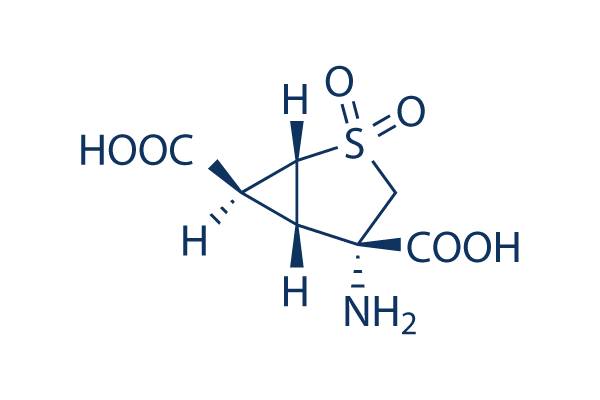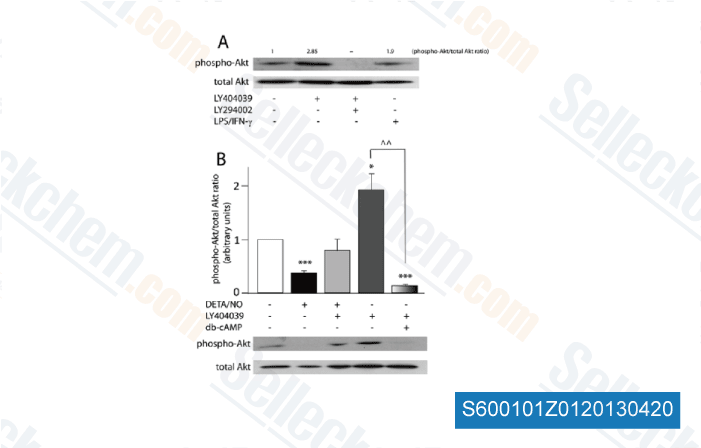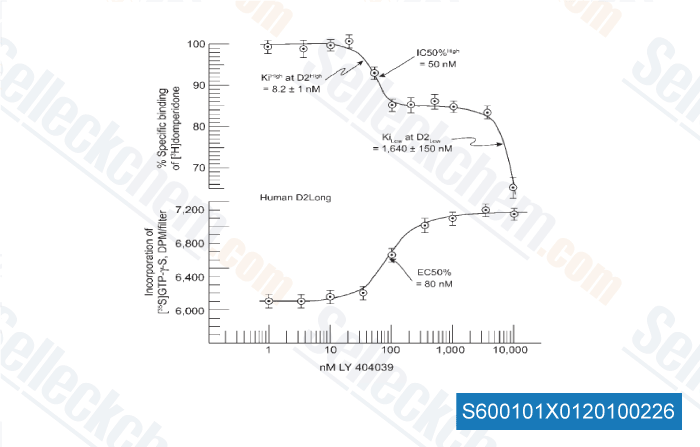|
受注:045-509-1970 |
技術サポート:tech@selleck.co.jp 平日9:00〜18:00 1営業日以内にご連絡を差し上げます |
化学情報

|
Synonyms | N/A | Storage (From the date of receipt) |
3 years -20°C powder 1 years -80°C in solvent |
|||
| 化学式 | C7H9NO6S |
||||||
| 分子量 | 235.22 | CAS No. | 635318-11-5 | ||||
| Solubility (25°C)* | 体外 | DMSO | 1 mg/mL (4.25 mM) | ||||
| Water | Insoluble | ||||||
| Ethanol | Insoluble | ||||||
| 体内 (毎回新しく調製した物を用意してください) |
|
||||||
|
* <1 mg/ml means slightly soluble or insoluble. * Please note that Selleck tests the solubility of all compounds in-house, and the actual solubility may differ slightly from published values. This is normal and is due to slight batch-to-batch variations. |
|||||||
溶剤液(一定の濃度)を調合する
生物活性
| 製品説明 | LY404039 is a potent agonist of recombinant human mGlu2/mGlu3 receptors with Ki of 149 nM/92 nM, shows >100-fold selectivity over ionotropic glutamate receptors, glutamate transporters, and other receptors. Phase 3. |
|---|---|
| in vitro | Pomaglumetad (LY404039) exhibits low binding affinity to group III mGlu receptors including mGlu6, mGlu7 and mGlu8 with a Ki value more than 5 μM. It shows little affinity for ionotropic glutamate receptors, glutamate transporter subtypes, monoamine and other receptors. This compound potently inhibits forskolin-stimulated cAMP formation in cells expressing human mGlu2 and mGlu3 receptors. It suppresses electrically evoked excitatory activity in the striatum, and serotonin-induced L-glutamate release in the prefrontal cortex. LY404039 could modulate glutamatergic activity in limbic and forebrain areas relevant to psychiatric disorders and may be devoid of negative side effects associated with current antipsychotics and anxiolytics. [1] |
| in vivo | Pomaglumetad (LY404039) demonstrates higher plasma exposure and better oral bioavailability, and may be valuable in the treatment of neuropsychiatric disorders, including anxiety and psychosis. [1] In wild-type animals, it significantly reverses d-amphetamine(AMP)-induced increase in ambulations, distance traveled, and reduced time spent at rest. This compound reverses phencyclidine (PCP)-evoked behaviors at 10 mg/kg. The antipsychotic-like effects of LY404039 on PCP and AMP-evoked behavioral activation are absent in mGlu2 and mGlu2/3 but not in mGlu3 receptor-deficient mice. In contrast, clozapine and risperidone inhibit PCP-evoked behaviors in both wild-type and mGlu2/3 receptor-deficient mice. [2] It reduces responding on the EtOH in the pavlovian spontaneous recovery (PSR) test and reduces the expression of an alcohol deprivation effect (ADE) during relapse, but does not affect EtOH responding under maintenance conditions. LY404039 inhibits the expression of alcohol seeking and relapse behavior without altering alcohol self-administration behavior. [3] Moreover, it attenuates amphetamine- and phencyclidine-induced hyperlocomotion. This compound could inhibit conditioned avoidance responding and also reduces fear-potentiated startle in rats and marble burying in mice. Importantly, it does not produce sedative effects or motor impairment in the conditioned avoidance task. LY404039 also increases dopamine and serotonin release/turnover in the prefrontal cortex. [4] |
| 特徴 | Under investigation as an exciting new medicine that may herald the arrival of third-generation antipsychotic drugs. |
プロトコル(参考用のみ)
| キナーゼアッセイ | Receptor Binding Assays | |
|---|---|---|
| [API调用失败: invalid chat.event: ping, {'event': 'ping', 'data': '{"timestamp_ms":"1764556574352"}'}] | ||
| 動物実験 | 動物モデル | Separate mGlu2 and mGlu3 receptor knockout mice are established. |
| 投薬量 | 10 mg/kg | |
| 投与方法 | Administered via i.p. | |
参考
|
カスタマーフィードバック

-
Data from [PLoS One, 2011, 6, e22235]

-
, , Dr. Philip Seeman, Department of Pharmacology, University of Toronto
Selleckの高級品が、幾つかの出版された研究調査結果(以下を含む)で使われた:
| Peripubertal mGluR2/3 Agonist Treatment Prevents Hippocampal Dysfunction and Dopamine System Hyperactivity in Adulthood in MAM Model of Schizophrenia [ Schizophr Bull, 2021, sbab047] | PubMed: 33928393 |
| The mGluR2/3 agonist pomaglumetad methionil normalizes aberrant dopamine neuron activity via action in the ventral hippocampus [ Neuropsychopharmacology, 2020, 10.1038/s41386-020-0764-2] | PubMed: 32663839 |
| Fully automated head-twitch detection system for the study of 5-HT2A receptor pharmacology in vivo. [ Sci Rep, 2019, 9(1):14247] | PubMed: 31582824 |
| Allosteric signaling through an mGlu2 and 5-HT2A heteromeric receptor complex and its potential contribution to schizophrenia. [ Sci Signal, 2016, 9(410):ra5] | PubMed: 26758213 |
| Allosteric signaling through an mGlu2 and 5-HT2A heteromeric receptor complex and its potential contribution to schizophrenia [ Sci Signal, 2016, 9(410):ra5] | PubMed: 26758213 |
| Glutamate Drug Reduces Dopamine Inhibition of Phosphorylation [Su P, et al. Synapse, 2015, 70:45–48] | PubMed: 26583745 |
| Heterocomplex formation of 5-HT2A-mGlu2 and its relevance for cellular signaling cascades. [Delille HK, et al. Neuropharm, 2012, 62(7):2184-91] | PubMed: 22300836 |
| Reduced cAMP, Akt activation and p65-c-Rel dimerization: mechanisms involved in the protective effects of mGluR3 agonists in cultured astrocytes. [Durand D, et al. PLoS One, 2011, 6(7):e22235] | PubMed: 21779400 |
| Glutamate agonist LY404,039 for treating schizophrenia has affinity for the dopamine D2High receptor. [Seeman P, et al. Synapse, 2009, 63(10):935-9] | PubMed: 19588471 |
長期の保管のために-20°Cの下で製品を保ってください。
人間や獣医の診断であるか治療的な使用のためにでない。
各々の製品のための特定の保管と取扱い情報は、製品データシートの上で示されます。大部分のSelleck製品は、推薦された状況の下で安定です。製品は、推薦された保管温度と異なる温度で、時々出荷されます。長期の保管のために必要とされてそれと異なる温度で、多くの製品は、短期もので安定です。品質を維持するが、夜通しの積荷のために最も経済的な貯蔵状況を用いてあなたの送料を保存する状況の下に、製品が出荷されることを、我々は確実とします。製品の受領と同時に、製品データシートの上で貯蔵推薦に従ってください。
